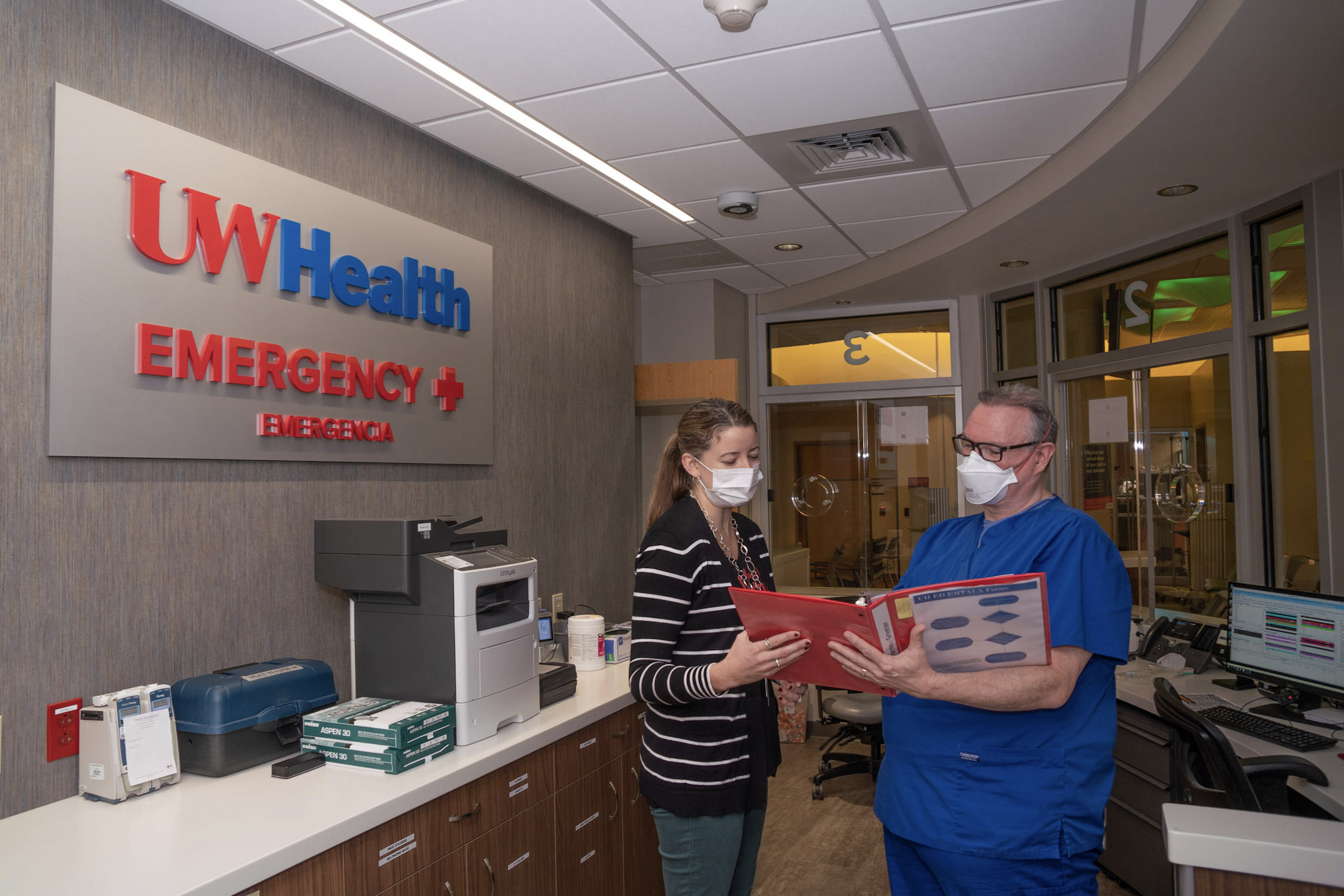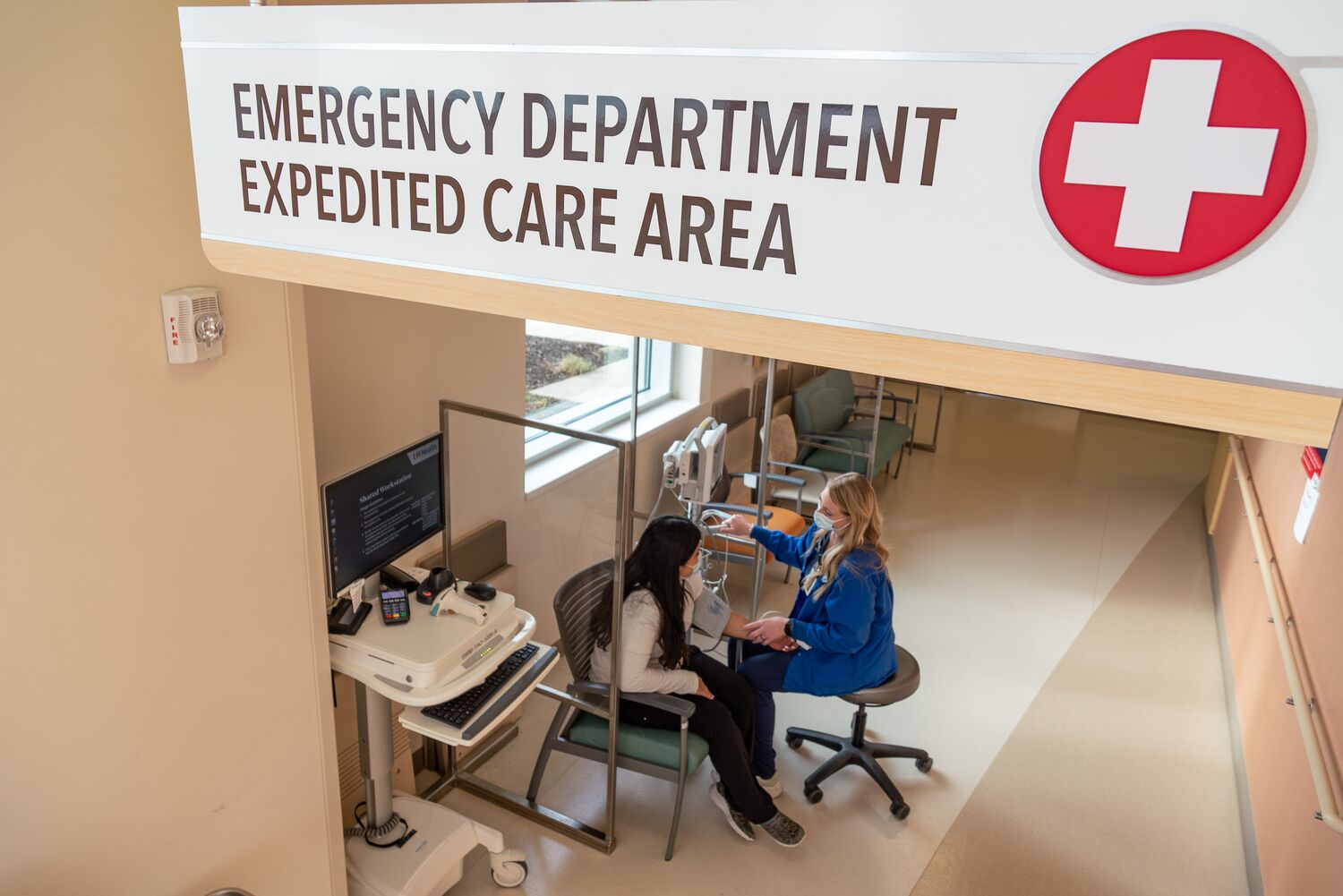When health systems are overwhelmed with patients, as they have been across the nation for the past few years, academic medical centers such as UW Health feel the pinch even more than most. Patients continue to need care, so the challenge is moving them through the system as efficiently as possible without compromising quality of care or patient safety.
“As a regional referral center, we see the sickest of the sick,” said Jacinda Krueger, RN, a supervisor in the UW Health BerbeeWalsh Emergency Department at University Hospital. “So, in addition to the patients who walk in the door, community hospitals that are not able to care for highly acute patients send them to us. In addition, Dane County’s population is growing at a higher rate than any other county in Wisconsin.”
In just three years, combined emergency department (ED) patient volume (University Hospital and East Madison Hospital) has increased from an average of 234 people per day (October 2019) to 278 per day (October 2022) — a 19% increase. Incidentally, more pediatric patients (1,904) were treated in the ED in November 2022, more than any month in UW Health history, a likely consequence of the spike in respiratory syncytial virus (RSV) and flu cases.
Emergency department overcrowding is a hospital-wide challenge


Patient crowding in the ED is usually a sign that the entire health system is stressed.
When there are no beds available throughout the hospital, patients who need to be admitted must either be moved to temporary holding areas in the hospital, moved to hallways on inpatient units or remain in the ED taking up treatment spaces.
These patients, referred to as “inpatient boarders,” are cared for while they wait, but the situation is far from optimal. In recent years, ED staff at both UW Health hospitals in Madison have worked to creatively address the space problem while also continuing to ensure that the sickest and most vulnerable patients are given highest priority in the queue.
Lower-acuity patients, such as those who have pneumonia or influenza, are often seen in a special part of the ED, treated and discharged or admitted directly from the front end of the ED. These areas — known as CareSTART and the Flexible Care Area at University Hospital, and the Expedited Care Area at East Madison Hospital — are overseen by a physician and advanced practice provider team.
Despite having only 58 ED rooms at University Hospital, staff have increased bed capacity to more than 80 patients through use of flexible treatment areas and converted hallways.
“With the record volumes we’ve been seeing, we’ve expanded our ability to care for patients by adding additional treatment spaces and evaluating which patients can be treated in chairs,” said Didi Buckley, BSN, RN, CEN, another ED supervisor at University Hospital. “This helps us reserve beds for the patients who truly need them,” she said.
East Madison Hospital Emergency Department ‘borrows’ adjacent space


Similarly, East Madison Hospital saw demand at its ED grow by 19% between Fall 2021 and Fall 2022, continuing a trend of double-digit, year-over-year volume growth. Staff at East Madison Hospital are also creatively addressing overcrowding by making efficient use of adjacent spaces.
“Within our Universal Care Center, we’ve been able to ‘borrow’ space from the pre- and post-surgical area adjacent to the ED,” said Melanie Hankes, BSN, RN, nurse manager of the East Madison Hospital ED.
Hankes credits Lindsey Lehner, MSN, RN, CNOR, director of perioperative services at East Madison Hospital, and Samantha Madsen, MSN, RN, manager of pre/post/PACU at East Madison Hospital, for being an accommodating neighbor by making certain pre- and post-surgical beds available to ED patients when Lehner’s unit volumes decline later in the day. Similar to the steps taken at University Hospital, East Madison Hospital also prioritizes its 16 emergency beds for the sickest patients.
“Certain patients are evaluated in our Expedited Care Area to reserve our beds for those who truly need one, while sending home others who can be safely treated without being taken to a bed,” Hankes said.
While ED crowding is unlikely to significantly diminish anytime soon, UW Health staff are encouraged by early signs, despite knowing that much work still needs to be done.
“Most people are pretty reasonable and understanding,” said Jackie Payne, BSN, RN, care team leader in the ED at East Madison Hospital. “Despite the growing volumes, our door-to-doctor wait times have remained stable. Of course, we would love to see wait times go down but the steps we have taken prevented them from increasing.”
Guest services staff add calm
Knowing how stressful an ED trip can be even during less crowded times, ED staff have gone out of their way to manage expectations by informing patients about the new procedures to handle higher volumes more efficiently.
“Communication with patients as they enter the waiting area goes a long way toward keeping stress levels in check,” Buckley said. “We are also grateful to Guest Services for extending its Guest Ambassador Program to the ED at University Hospital.”
A longtime hospitality hallmark of the Surgical Waiting Area at University Hospital, guest ambassadors — conspicuous by their bright red shirts — warmly greet patients and family members, help familiarize them with the surroundings and provide a much-appreciated sense of comfort and reassurance.
“We’ll provide a blanket if someone is cold,” said Stephanie Bracken, Guest Services supervisor. “We’ll escort loved ones to the visitor waiting area down the hall, take people to the cafeteria or accompany them to their car when it’s time to leave. The goal is to enhance the guest experience in a stressful situation for both patients and loved ones.”
Check out more stories featuring the great work of our nurses in the 2022 Nursing Annual Report (pdf).
